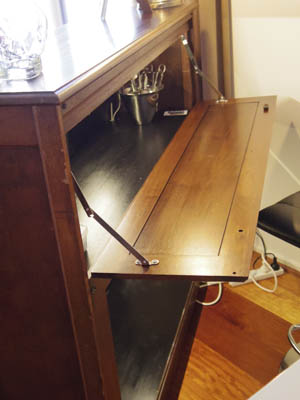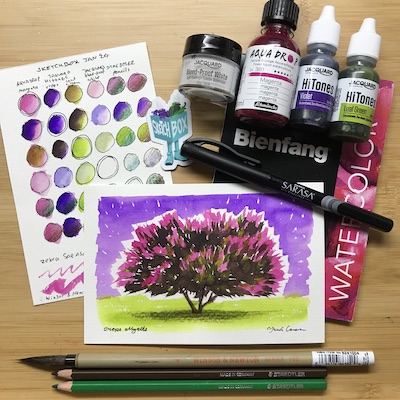Last week I went to King Island for a week. The same sketchbook I used on Lord Howe Island and Norfolk Island came with me, and I painted in it every day. I was hoping to finish it, but I came four spreads short. I guess I’ll have to go on a long weekend trip to another island to finish it.
Though I did take a small watercolour set, it was a backup. My intention was to use acrylic gouache. In the two weeks leading up to the trip I painted with watercolours and then acrylic gouache at a plein air outing, to warm up and decide which to take. The latter won by a mile. Though I to like watercolour, I can’t escape the fact that working dark to light, and layering paint, suits me better.
My kit consisted of an A4 piece or thin corflute with a metal strip stuck to it. My water jar and bottle of drying retarder have little magnets from an old phone cover on their bases, so this keeps them from tipping over or blowing away (the latter was very relevant to King Island). Everything but the corflute fit into an old “bum-bag”: paint tubes, brushes (in a toothbrush container), clips, rags, pencil, pens, eraser and sharpener. I cut down the weight and bulk of them by using hat elastic to hold the sketchbook and palette to the corflute.
The palette was the main mid-holiday tweak. During the plein air session I testing the gouache at, my paints were drying too fast despite the retarder medium. One member suggested I create a “stay-wet” panel out of a plastic container, sponge and baking paper. I found a little container that fit into the front pocket of my bag perfectly, but it proved too small. So I found a sandwich box at a supermarket that proved to be a much better size.
I expected the spreads to take more than an hour to complete, but they usually came in under that.

Walking along the beach near our accommodation, I thought I would paint the waves and sand, but I was utterly charmed by the local copses of tea tree, with their pale trunks against the shadowy interior. The island was very dry, but as the week passed and rain fell overnight, a little green did start to return to the fields.

The Boathouse, also known as “The Restaurant With No Food”, at Currie Harbour. It contains tables set out with cutlary, etc. so you can BYO your own meal, and presumably wash up after. When we first visited a gathering was underway, which turned out to be a group of artists on a tour. The teacher and of the students were outside. The student was old, male, and talking to the teacher in a grunty way certain men have when they feel they are an expert. As I painted the building with the lighthouse in the background the other artists emerged and set up to paint, and he began moving about giving uninvited advice. Later, I mentioned this to a tour guide and she said “Oh, yes, I know the one.”
One of the artists sat down directly between me and the Boathouse, which I would have thought was the height of rudeness among plein air artists. Thankfully, I was nearly done.

Grassy Harbour. Penguins roost in that long jetty.

Cape Wickham Lighthouse from the road to the golf course.

Seal Rocks. It was so windy I gave up after doing the pencil outline. But as I stepped off the viewing platform I found myself in a sheltered spot with almost the same view. So I sat down and painted, doing the lower half mostly from memory. When I was done I compared the remembered bit with reality and was surprised to find it was fairly accurate. Maybe all this plein air painting is improving my memory. Well, my memory for scenes, not people’s names or where I put my phone.

Yellow Rocks River, where swans kept drifting past hoping to be included in the picture.

The one I did have to give up on doing in person. Because of march flies. Those little blighters are Nasty. I’d only encountered them once, the day before, when I was bitten on the knee through my pants. so I think I caught the very beginning of march fly season.
King Island is lovely and there were so many more views I wanted to paint. I’d love to return with a small groups of artists one day. Though it was early autumn and the weather was still warm, there were no crowds of tourists. The food was fabulous – it is best known for it’s beef, dairy and seafood – and the people friendly. I think I chatted to locals more than I ever have on a holiday before. The only down side was that there was a lack of reliable tourist information – and at one point we retreated from a road that was described as “an easy drive with caution” that turned out to be a 4wd track totally unsuitable for our hire care. Most attractions required driving on unsealed roads, some which might be dangerous in wet conditions. There are tour packages, but if you want to visit independently you’ll need to do a bit more work than usual and a bit of double-checking to be sure of the actual opening hours for the time you’re there.




















